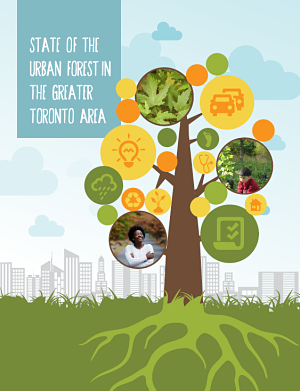Residents across the Greater Toronto Area watched trees fall and branches break as the most recent storm moved across the region. Many residents lost power and hydro crews had to work around the clock to repair downed electrical lines.
Tree damage caused by weather events can never be entirely prevented. Trees are living, dynamic structures that will naturally succumb to forces of nature as they age. They are, of course, critical to our cities: the essential services our urban forests provide far outweigh the occasional discomfort these trees may indirectly cause. However, there are steps that residents and all levels of government can take to prepare the urban forest for these events and reduce potential damage. In particular, we need to increase our commitment to proper tree risk management and plant new trees with the future in mind.
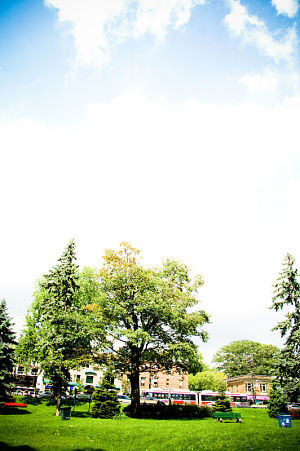
One small part of Toronto’s urban forest.
Tree risk management boils down to monitoring and maintenance. Tree health monitoring by certified arborists is essential in order to understand the risks and vulnerabilities that exist in our urban forest. Frequent and comprehensive monitoring can support the early identification of potential safety hazards allowing for preventative action, or can simply confirm that management activities have been successful.
There are two key maintenance activities that can minimize risk. The first is regular, preventative inspections and pruning, which removes and corrects structural weaknesses that may increase risk of breakage during wind and ice storms. In addition, proper pruning can allow for better clearance for vehicles and pedestrians, improved health and appearance and enhanced view. The second activity is protection of tree roots during construction or excavation. Severed roots can cause tree instability and increase risk of uprooting during windstorms. Laying down patio stones or adding a driveway to your lot may seem harmless, but if roots are severed the tree may be set up to fail in the next storm. To protect the trees and your property, it is best that only qualified arborists with demonstrated experienced carry out this work. Improper pruning or inadequate root protection can be extremely damaging to tree health, and can create future safety threats.
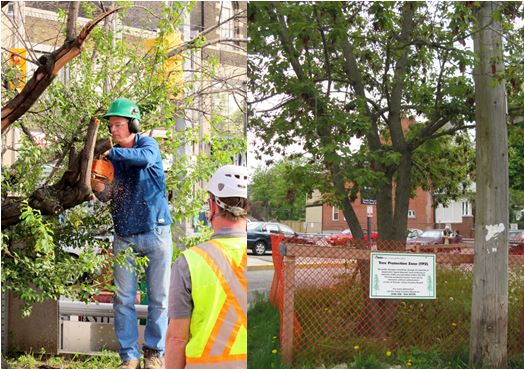
An ISA certified arborist preventatively pruning a street tree (left); a tree protection zone sheltering a street tree from construction (right).
We also need to be better at planting trees now for the future. Sometimes, issues arise from poor planning decisions in the past, when trees were planted in spaces that led to conflicts with hydro lines, underground infrastructure, or buildings. So when we plant new trees, we need to consider how their future growth will intersect with the grey infrastructure in our urban environment. We also need to consider how these trees may respond to more extreme weather events that are anticipated.
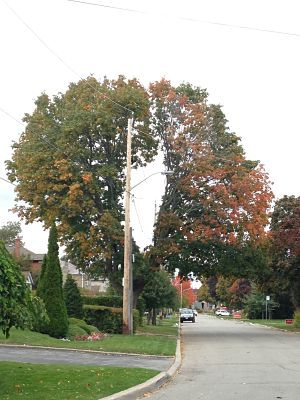
Poor tree placement directly under hydro lines.
To be successful, we’ll need support from all levels of government. This support could come in the form of nursery standards that require tree stock with healthy root systems, and through soil conservation standards and minimum soil volume requirements that will help ensure our trees have better rooting environments – after all, roots are the anchors of trees. Natural disasters often cross multiple municipal boundaries so planning for them at regional and provincial scales will be help us be better prepared.
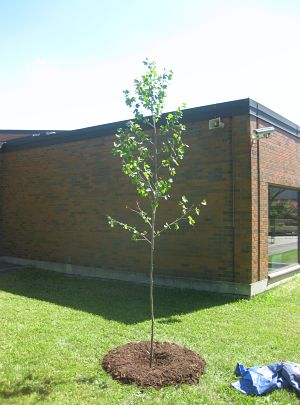
Tree planted in an urban area with adequate space.
With the changing climate and associated extreme weather events, our trees, our property and our safety could be at risk without investment in proactive urban forest management. The urban forests of Ontario are helping to create the healthy communities that we all want – ones with cooler temperatures and cleaner air and water. So let’s work together to grow and maintain this vital green infrastructure.
Click to read The State of The Urban Forest report, authored by The Green Infrastructure Ontario Coalition.
The Green Infrastructure Ontario Coalition promotes awareness and understanding of green infrastructure, and advocates for policy and activities that increase implementation of green infrastructure across Ontario. Visit www.greeninfrastructureontario.org for more information, including excellent urban forest resources.
Janet McKay the Executive Director at LEAF and is a founding member of the Green Infrastructure Ontario Coalition.
LEAF offers a subsidized Backyard Tree Planting Program for private property. The program is supported by The Town of Newmarket, The Regional Municipality of York, City of Toronto, Toronto Hydro, Oakvillegreen, Town of Ajax, and Ontario Power Generation. For details on how you can participate, visit www.yourleaf.org.

